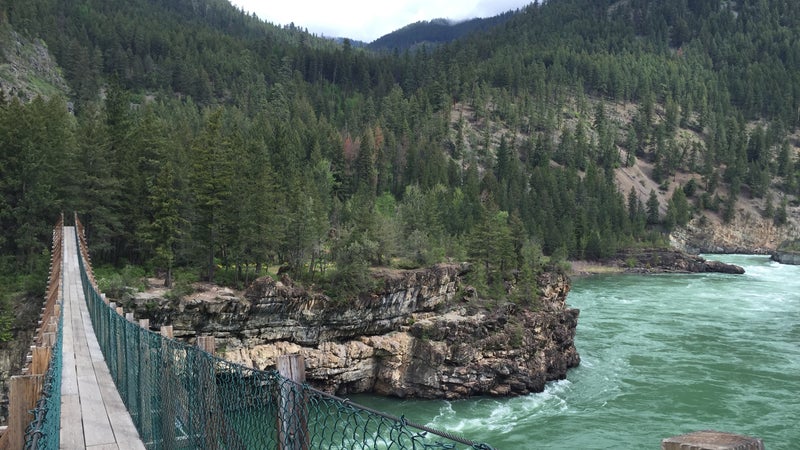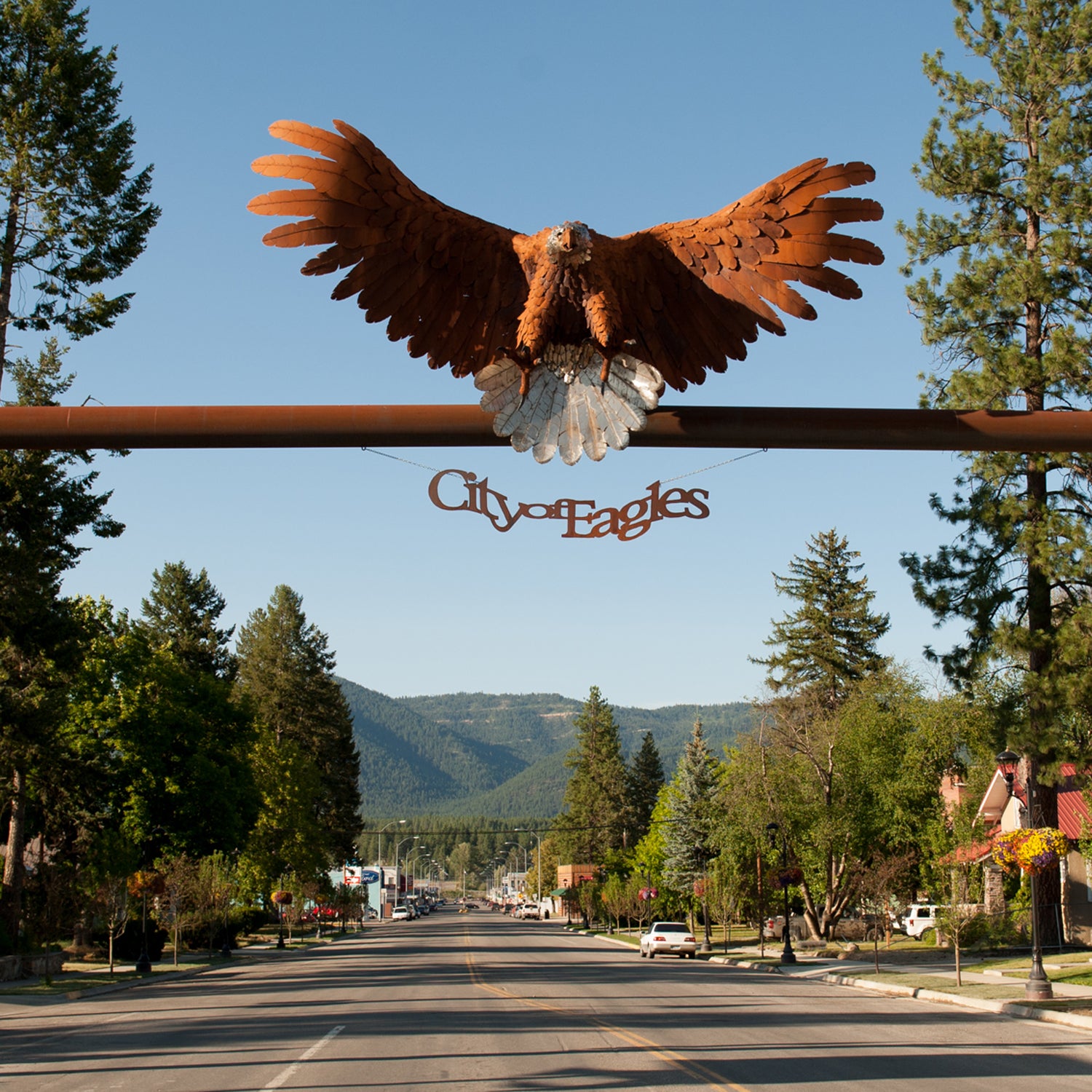There’s a town in Montana that’s like Big Sky Country was 50 years ago. It’s spread out in a pastoral valley beneath snowy mountains. A river runs through it, glacial-green, with class IV rapids and record rainbow trout. Two miles from downtown, a wilderness area stretches for 94,000 acres, replete with cedar groves, craggy peaks, and alpine lakes. It’s remote, and yet there’s a yoga studio, a craft brewery, and a ski hill.
Welcome to Libby, Montana, population 2,600. For all its attributes, you’d think it would be a regular contender in ���ϳԹ���’s annual Best Towns competition, like Telluride, Colorado, or Burlington, Vermont. But Libby has some baggage.
From 1919 to 1990, the town mined 80 percent of the world’s vermiculite—a mineral that expands with heat and is used in insulation, fireproofing, and soil conditioning. Residents filled their pickups with vermiculite tailings to mix into their home gardens. They used it to insulate their homes and to fill local playgrounds.
But Libby’s vermiculite also contains asbestos. Miners spent decades breathing its toxic dust. By the 1990s, hundreds—a full tenth of the population—were dead. Almost 20 percent had lung abnormalities. In 2002, the EPA declared the area a Superfund site, calling it the worst environmental disaster in U.S. history. The mine’s owner, W.R. Grace, agreed to pay $250 million toward the town’s cleanup. In the meantime, the Chamber of Commerce was fielding calls from concerned motorists asking if it was safe to drive through town with the windows rolled up.
After decades of doom, Libby finally got some good news this February, when the EPA announced that its air quality surpassed most Montana towns. They said the cleanup will be complete in 2020—20 years and $600 million after it began.
Libby residents are hoping the bill of health will breathe new life into the place. A band of locals—with help from the University of Montana’s School of Business Administration and a Missoula marketing firm—wants to use the opportunity to rebrand their town. They hope to draw in tourists and new residents by highlighting Libby’s beauty, remoteness, and sense of adventure.
“I look at Libby and see nothing but potential,” says county commissioner Mark Peck, who graduated from Libby High (home of the Loggers) in 1977, when the town was still booming. Over the years, he watched Libby spiral downward. Now he hopes to see it rise from the ashes.
“We’re not where we want to be,” he says, “but in three to five years, we’re going to see a completely rejuvenated community that’s just a fantastic spot to visit and live.”
Dozens of towns have resurrected themselves after environmental contamination, economic collapse, or natural disaster—towns like Greenville, South Carolina, Duluth, Minnesota, and Leadville, Colorado. But even more have tried and failed. The question is: What separates the two? How does a town reinvent itself? And what lessons can rebounding communities offer those looking to make their own hometown one of America’s best places to live?
Identify the Strengths
Mining was also the raison d’être for Leadville, Colorado. Gold was discovered here in 1860. Silver, lead, copper, and molybdenum kept the town rich through the early 1980s, when the county had the highest per-capita wages in the state. But the Climax Mine closed in 1982, and the EPA designated the area a Superfund site. The Leadville economy collapsed.
That’s when out-of-work miner Ken Chlouber turned to the town’s topography for relief. Chlouber thought that Leadville’s natural gifts—10,000 feet of elevation and an abundance of trails—made it the perfect place to host an elite endurance run. When he started the Leadville 100 in 1983, 45 runners competed. Today the town hosts six long-distance running and mountain biking events, which bring more than 16,000 people to the 2,600-person town each summer. Some locals worry that the race season is , but the events pump $15 million annually into the county’s economy and have helped Leadville persist despite its ongoing Superfund status and the mining industry’s decline.
Libby is hoping to capitalize on its races, too. Cycling season starts in May with the (STOKR), a 98-mile ride that attracts up to 450 riders. July brings the 174-mile , from Libby to Eureka. The 83-mile is held in August along the picturesque shores of Lake Koocanusa, and some 140 riders turn out to benefit local search and rescue.
To Libby locals, the landscape isn’t just a racecourse; it’s a million-acre playground. Kootenai Falls, where part of “The Revenant” was filmed, is the site of some epic kayaking drops. The 2.2-million-acre Kootenai National Forest offers prime mountain biking, trail running, rock climbing, floating, fly fishing, and hunting. In winter, Turner Mountain, the local ski hill, is staffed by volunteers. Bigger terrain is two hours away, at Idaho’s Schweitzer Mountain or at Big Mountain in Whitefish.
“This place is just absolutely killer from a recreational standpoint,” says commissioner Peck. “How many towns are this close to a wilderness area?”

Embrace the Weaknesses
The problem is, while Libby is close to wilderness, it’s not close to much else. But towns do well when they can turn their weaknesses into strengths. , in Duluth, Minnesota, for example, is an abandoned eyesore of the town’s industrial past. But when local climbers bolted routes into the quarry’s 100-foot cliff, the place was reborn. The Duluth Climbers Coalition is now turning the site into a full-fledged climbing park.
Libby’s most obvious drawback—aside from its Superfund status—is its isolation. The town has an Amtrak station, but it’s two-and-a-half hours from the nearest interstate. Getting there requires a committed drive along winding state highways. That may deter some, but it attracts others. People don’t go to Bar Harbor, Maine, for its nightlife. They don’t go to Houghton, Michigan, for its dining. People come to towns like these to be alone in nature.
“Libby’s remoteness is actually its greatest strength,” says Kevin Keohane of Partners Creative, the Missoula marketing firm helping Libby rebrand itself. “It’s Montana as Montana ought to be. It’s untapped. It’s just as good as Glacier without five rows of cars.”
Partners Creative has crafted messaging and analysis for Libby. (The central theme of that messaging is, aptly: “Libby: Nothing else is even close.”) The town has yet to launch an ad campaign because once a town rebrands, Keohane warns, it has to live up to the promises. Libby is still laying the groundwork for its renewal, but the community is rallying around the idea.
“We’ve got old crotchety hermits, guys carrying guns, and people walking around barefoot with longboards,” says Cass Hopkinson, a local wildland firefighter. “People here definitely cut their own wood. They don’t like the government meddling. But it’s still a community. People help each other.”
Libby’s asbestos contamination has even created some paradoxical plusses. With half a dozen medical centers, the healthcare in Libby is far superior to most towns of its size. And the town’s houses, recently cleaned of asbestos by the EPA, are more affordable than most in Western Montana, starting around $120,000.
“The market is great,” says Sharron Sverdrup, owner of Kootenai River Realty. “The typical buyer is a retiree now. The outdoor activities here are incredible; it’s beautiful; the cost of living isn’t that high; and there’s no traffic.”
Boost the Economy
One of the ways Provo, Utah, reached Best Town status is by making the city attractive to businesses. The city created Camp 4, a public-private initiative to incubate startups. It also adopted business-friendly tax policy that helps retain giants like Google Fiber, Adobe, and Ancestry. Now Provo has an $18 billion economy and an unemployment rate of 3 percent—half the national average.
This may be Libby’s biggest obstacle to becoming a Best Town. Tina Oliphant, director of the Kootenai River Development Council, says Libby was suffering from the decline of logging and mining even before the Superfund stigma. Today Libby’s major employers are the Forest Service, hospitals, and the EPA. The unemployment rate is 13.4 percent, and the median household income is just $27,000. Mineral Avenue, which locals call “the Gut,” is a parade of faded, vacant storefronts. It has an apocalyptic, Twin Peaks feel.
But if there’s hope, Oliphant says, it’s a 400-acre property that used to be the Stimson Lumber Mill. The land comes with rail access, which Libby is paying $2 million to modernize. Oliphant calls the area the Kootenai Business Park. She hopes to get it delisted from Superfund status so that it can be developed into a manufacturing facility, say. One of the site’s advantages is Libby’s lack of zoning restrictions. “We like dirty, dusty, and loud,” Oliphant says.
A silver and copper mine is awaiting approval for the east side of the Cabinet Mountain Wilderness. Commissioner Peck, along with many in the town, hopes that mine opens, but he also wants Libby to expand its tourism, lure in retirees, and attract young entrepreneurs who want to open up shop in a beautiful place.
“We’re open for business,” says Peck. “We’ve got good rail access. We’re not that far (about 400 miles) from seaports. For the last 20 years, we’ve dealt with these major negatives. But we’re at a point where we can overcome that now. And the town is ready.”
On a Friday evening, the most happening downtown establishment appears to be Cabinet Mountain Brewing Company, where a four-wheeler is parallel parked at the curb. Kristin Smith opened the brewery with Sarah Sorensen in 2014, after watching a brewery revitalize Philipsburg, another Montana mining town. Cabinet Mountain is the first female-owned brewery in the state.
“We bill ourselves as Libby’s living room,” Smith says. “We’ve become an anchoring entity downtown. We’re seeing more foot traffic, more cars. We’re happy to see people build on that.” Not long after the brewery opened, Find Your Light Yoga popped up down the road. Still, Libby’s downtown is a long way from vibrant.
“We are a community in transition,” says commissioner Peck. “Natural resource extraction will always be a cornerstone of our economy, but we have to diversify.”
Invest in ���ϳԹ���
Libby’s plight is familiar to Bill Baker, a Portland-based marketing strategist and author of . Baker says Libby reminds him of Oakridge, Oregon, a 3,200-person town that went into an economic spiral when its logging industry collapsed in the early 1990s. But Oakridge was able to use its past to craft its future. “One legacy of the forestry industry was hundreds of miles of trails,” Baker explains. “It’s now a major mountain biking destination.”
For a small town to reinvent itself, Baker says, it needs to be “laser-focused” on identifying and promoting its greatest strength. It’s not enough to talk of a town’s outdoor potential, he says, without singling out an activity at which the town excels. Baker doesn’t recommend traditional advertising for towns like Libby, either, but rather a slick website and smart use of social media. It also helps to manage expectations.
“There’s not going to be an overnight turnaround,” he says. “It’s going to take a long time to knock asbestos off the front page of Google. It may be a generational thing. It’s a long journey.”
Still, it beats the alternative. “If you’re not growing, you’re dying,” Baker says. “It’s as simple as that. You can’t just tread water.”
For a good quality of life, a town needs trails, parks, and restoration projects. Some towns finance this outdoor infrastructure with a special lodging tax. Duluth, Minnesota, levies a 0.5 percent tax on hotels, restaurants, and bars. That tax is expected to generate $18 million over 15 years and will help fund recreational opportunities along the St. Louis River.
Greenville, South Carolina, a former mill-town on the Reedy River, spent $13 million to create the 32-acre around a waterfall that was once obscured by an overpass. Within two years, Falls Park was surrounded by $150 million of private investment, in restaurants, condominiums, and retail.
Libby has no projects of that magnitude in the works, but locals are investing their own labor into grassroots adventure projects. The Kootenai Mountain Riders—a chapter of the International Mountain Biking Association—is sketching out plans for a mountain bike park and two in-town pump tracks, in Libby and in nearby Troy. A group of skiers is constructing a biathlon course. And a small grant enables Libby residents to rent cross-country skis for $25 a season from the local high school.
Kristin Smith, the co-founder of Cabinet Mountain Brewing, recently drafted a grant application for a master plan for existing and proposed trails around Libby. The town cobbled together $15,000 to pay Eastern Washington University to conduct initial planning on connecting Libby to more than 130 miles of trails in the Cabinet Mountain Wilderness and other areas. “Getting a good trail plan shows people that we’re growing up,” Smith says.
Don’t Get Too Cool
When Kevin Keohane drove up from Missoula to Libby to conduct listening sessions on rebranding the town, he kept hearing the same thing: “We don’t want to become another Whitefish.”
Like Libby, Whitefish is also a former logging town on the Great Northern Railway. Just two hours east of Libby, its fortunes have been vastly different thanks to its proximity to Glacier National Park and the development of Big Mountain ski resort in the 1940s. The town has rapidly developed with outside money, which has created a high tax base. Now the 6,400-person town has a literary journal, an annual food festival, and First Thursday art walks.
But Whitefish’s success has driven up home prices, forcing blue-collar workers to nearby Kalispell or Columbia Falls. Locals don’t want to see the same happen to Libby. That’s a sentiment countless towns can relate to, and not just in Montana. Every year, ���ϳԹ��� hears from angry residents in places like Durango, Colorado, Bellingham, Washington, and Middlebury, Vermont, who would prefer that the magazine didn’t trumpet their town for fear that it will lose its authenticity.
“Libby wants to stay Libby,” Keohane says. “They want steady, sustainable, long-term growth that doesn’t destroy what they’ve got. It’s a place that ought to always keep a little of that rustic edge.”
Partners Creative identified several types of individuals who might be drawn to Libby, including “eccentric entrepreneur,” “independent outdoor lover,” and “fiercely independent business owner.” Still, Keohane acknowledges that a town emerging from a huge environmental disaster in a remote corner of Montana with isolationist locals might not be for everyone. And he knows Libby lacks the white-tablecloth comforts of Whitefish or other adventure towns.
“It’s not a five-star experience,” Keohane says. “It’s for people who want to have a base of operations, get a decent meal, but really enjoy the outdoors, without a huge crowd.”
For some, that sounds a lot like paradise.


